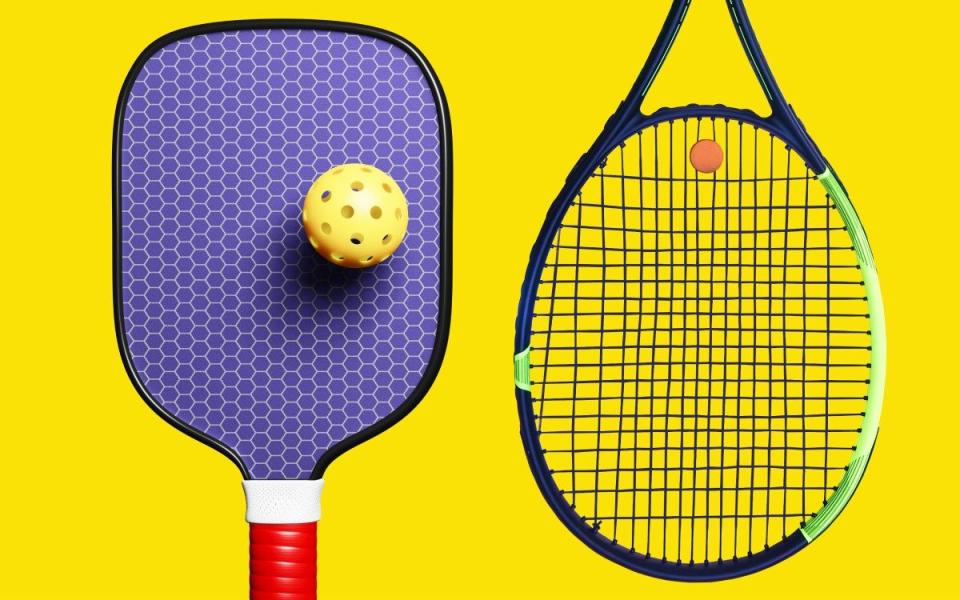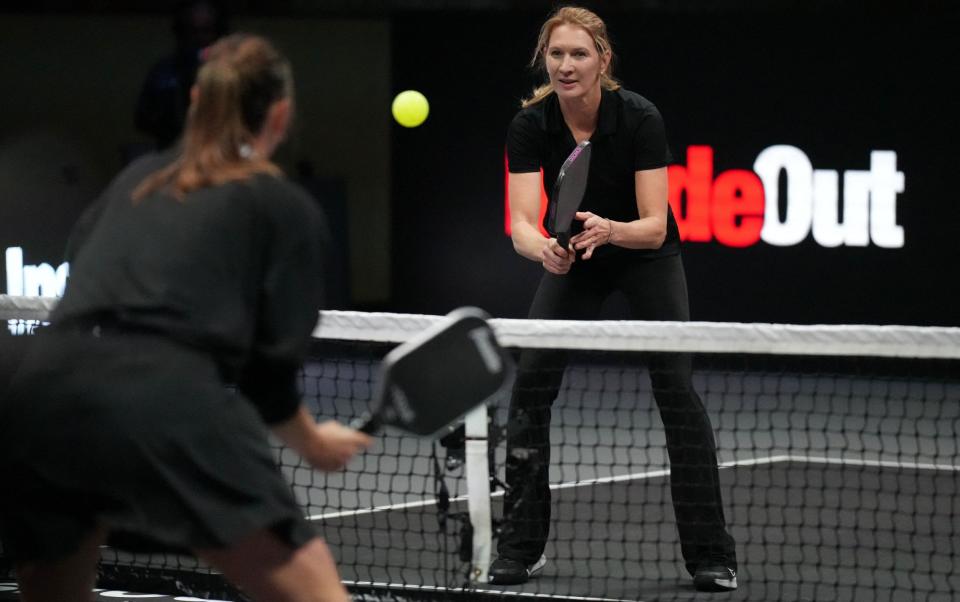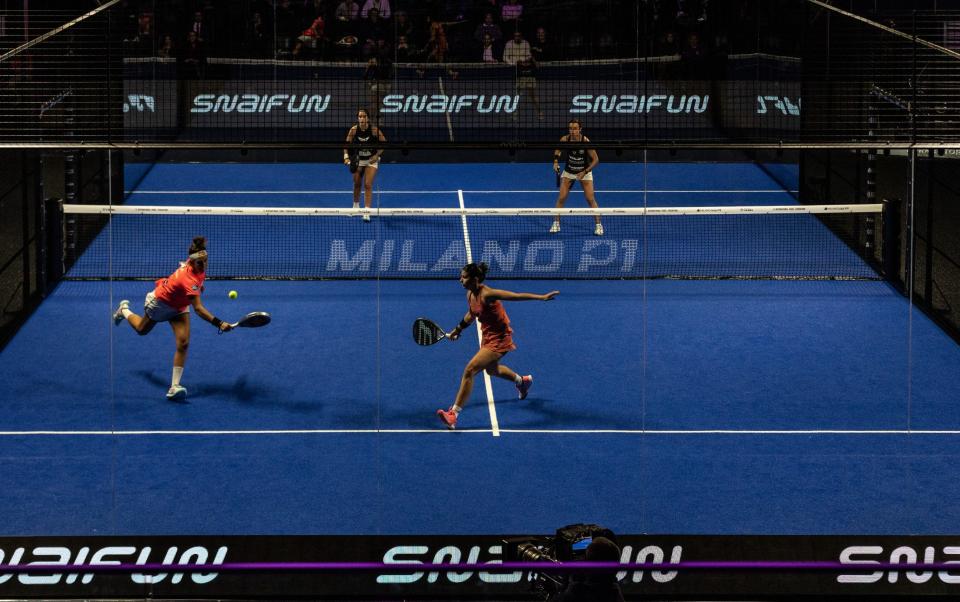Racket sports at war: Pickleball and padel take on the LTA

Ever heard of pickleball? A fast-paced, low-impact cross between tennis and ping-pong, it is America’s most up-and-coming sport. Celebrity fans include former NFL quarterback Tom Brady, fashion diva Kim Kardashian and actor Leonardo DiCaprio.
So far, pickleball remains in its infancy on this side of the Atlantic. We have perhaps 12,000 regular participants, as against the United States’ nine million. But it has obvious potential for growth, which may explain why it has become the subject of a prickly custody battle.
With a forthcoming board meeting of Sport England to consider pickleball’s fate, the new breed of racket sports – which also include the related discipline of padel – are entering an intriguing few weeks.
The awkwardness stems from a simple question: who should run pickleball in this country? Should it be the Lawn Tennis Association, which has been administrating padel – with debatable results, according to many insiders – since 2019? Or should it be the band of enthusiastic volunteers who established Pickleball England in that same year?
This is the choice facing Sport England, which is expected to take another look at it in late March. The issue was referenced in the House of Commons on Thursday, with Conservative MP Andrew Selous asking: “Can we recognise pickleball as a national sport?” and under-secretary of state Stuart Andrew replying: “Anything that gets people active can only be a good thing.”
According to James Chaudry, a three-time national champion and Pickleball England board member, this short exchange raised some important points.
“We met the LTA several times last year and their proposal didn’t recognise pickleball as its own sport,” Chaudry told Telegraph Sport. “They want it to be part of their ‘Tennis Opened Up’ strategy, aimed at younger and older players. Our contention is that pickleball deserves to be treated on its own, not as a feeder sport. It’s easier to pick up than tennis, and doesn’t require the same court coverage. All of which makes it incredibly inclusive, and potentially beneficial to the Government’s Get Active strategy.”
This feels like a David and Goliath story. On the one side, the amateurs, led by retired former American Express executive Karen Mitchell, who have run three well-attended national championships. On the other, the LTA, with its £80 million income and 325 employees.

The bigger organisation says it has the resources and know-how to grow pickleball’s player base. The outsiders reply that the two “Ps” will always be the poor relations in any notional LTA family of racket sports, and suggest a potential conflict of interest.
According to this theory – which is strenuously denied at the LTA’s Roehampton headquarters – there is an incentive to avoid a sudden explosion in either padel (as happened in Spain and Sweden) or pickleball (as happened in the US). Better to keep the younger sports under control, ticking along without taking too big a bite out of tennis’s traditional player base. Otherwise, the LTA could be accused of nurturing a cuckoo in the nest.
Sport England – which told Telegraph Sport that “it would be pre-emptive to comment further at this stage” – will effectively be the referee in the fight over pickleball’s future. In all probability, it is hoping for a repeat of the amicable merger that saw the LTA swallow up padel: another tennis-based hybrid which incorporates elements from squash.
Extremely popular in Europe, padel was an earlier visitor than pickleball, arriving on our shores when Tom Murray – a former Futures-level tennis player from Kent – formed a nascent British Padel organisation in 2014.
But then, after five years of sustaining his new body in his spare time, Murray agreed to something resembling a corporate buyout: the LTA would henceforth run the sport with him as its head of padel. “It was a dream come true,” he told Telegraph Sport last week.
The success or otherwise of the LTA’s padel project has obvious relevance for its American cousin. At Pickleball England’s AGM, held on Feb 18, Chaudry recommended that members should “speak to people within the padel world, see what the impact is of the LTA having taken over padel, and come to your own conclusions.”
So, how do we assess the sport’s performance over the five years since the Murray merger? In that time, the number of courts in the UK has grown roughly sevenfold, from around 50 to approaching 350. Yet this has been driven almost entirely by private investors, while the LTA has erected only three courts in Roehampton and handed out £3.9 million in padel-related building loans to tennis clubs.
When Telegraph Sport approached those private investors, there was little warmth expressed towards the LTA. Inflexible rules and poor communication were cited several times, even if no one wanted to be quoted by name for fear of reprisals. As one source put it, “I’ve had this conversation with everyone in padel from club operators to top players, juniors, parents and tournament directors. I get a pretty consistent message back: the LTA get in the way more than they help.”
Asked about these misgivings, Murray replied: “A lot of people might not see a lot of the work that’s going on behind the scenes, because padel is growing slowly, if you compare it to other things. But I don’t think it would be where it is today without the LTA having integrated it, because it wasn’t officially recognised.”

Murray also said that the next three years will constitute stage two of the project, now that “every team at the LTA is now delivering on both tennis and padel. When it comes to the private operators, they might be entrepreneurs who haven’t come from a sports background, so they’re not used to the tennis ecosystem: registering venues, safeguarding standards, making sure it’s safe to play.”
One curiosity about Murray is that everyone Telegraph Sport spoke to said that he lives in Alicante in southern Spain – an international padel hotspot – with one person adding: “It’s a strange and unsatisfactory situation, as if the head of English cricket were living in Pakistan.”
Murray replied that this is no more than a rumour, born out of his wife’s Spanish nationality. “I’m a UK tax-payer,” he said, “based down in Kent.” But the very existence of the rumour says something about his visibility, or lack of it, around the national padel circuit.
For the moment, the dominance of tennis – which last year recorded its best participation figures in more than a decade – is not being seriously challenged in the UK. The LTA has identified 5.6 million tennis players, it says, as against 175,000 padel players and those 12,000 pickleballers we mentioned earlier.
Yet these are highly committed communities, as Mitchell demonstrated when she built a back-garden pickleball court during the pandemic. According to Chaudry, there are already 1,200 people signed up for August’s national championships in Telford. And there is plenty of bustling activity behind the scenes: after considering cases from other sports, including walking football’s fight to be run separately from the Football Association, Pickleball England recently filed freedom-of-information requests into Sport England’s decision-making process.
For the moment, the passions at play exceed the numbers involved, but that could change quickly if pickleball finds its groove. The next moves in this saga will be closely watched.
Recommended
My afternoon playing pickleball with Tim Henman

